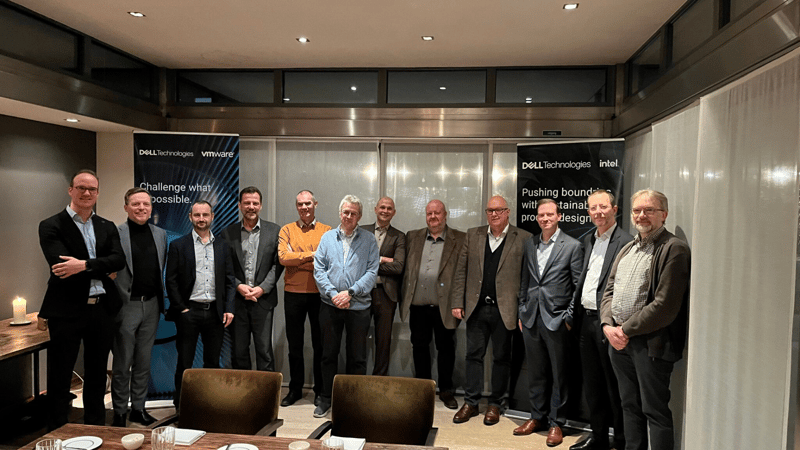
Blog article based on the discussion at the Roundtable set up by CIONET in partnership with Dell Technologies & Intel Corporation on Thursday February 1, 2024.
On the evening of February 1st, 2024, the restaurant ‘Het land aan de overkant’ in Leuven hosted a notable roundtable discussion, a joint initiative by CIONET, Dell Technologies, and Intel Corporation. The event brought together 14 digital leaders to delve into the transformative impact of edge computing on artificial intelligence (AI) and cloud technology.
Koen Segers, Dell Technologies Belgium and Luxembourg's Managing Director kicked off the proceedings by sharing Dell Technologies' reasons for backing the roundtable. The focal point of the conversation was the synergistic relationship between cloud and edge computing, emphasising how edge computing is reshaping conventional data processing by bringing it closer to the source. This shift is crucial for real-time AI applications that demand immediate processing. Tom Olislagers, Koen’s colleague and the Solutions Architecture lead at Dell Technologies, highlighted an upcoming trend: a surge in decentralised data, projected to exceed 75% soon. The discussion pivoted on strategising effective management of this increasingly decentralised data landscape.
Hybrid by choice
Timothy De Ben, IT Infra Manager Belux & CISO Benelux, started his presentation by shedding light on the operational scale and the strategic adoption of edge computing within DPD, a leading parcel handling company.
DPD has significantly scaled its operations, thanks to a substantial investment of 250 million euros in recent years. This financial infusion has enabled the company to handle an impressive volume of 750,000 packages daily, supported by a global workforce of 112,000 collaborators. Within Belgium, DPD operates across nine sites, each generating a vast amount of data due to the extensive use of various devices, including cameras that produce over 750 terabytes of images per month at each location.

In addressing the company's data processing strategy, Timothy detailed how DPD has embraced a 'hybrid by choice' approach. This method strategically balances local data processing with the scalability offered by cloud solutions. The majority of data is processed locally through edge computing to enhance efficiency and response times. The decision-making process regarding where data is processed hinges on its value—local processing is preferred for data with immediate, site-specific value to save on costs and bandwidth, while data with scalability potential is centralised in the cloud.
Timothy further elaborated on the focus placed on evaluating the importance and utility of each data type. This evaluation is crucial for prioritising actionable data, such as battery statuses from drivers' devices for preventive maintenance purposes. Through this meticulous data analysis, innovations such as shock detection on drivers’ devices have been developed, significantly impacting driver management and material handling processes.
A crucial aspect of Timothy's presentation was the emphasis on data governance. He highlighted the imperative need for robust data governance frameworks to ensure consistency and accuracy across all departments. Timothy pointed out their current search for dedicated data managers to navigate the complex data landscape, underscoring the challenges in maintaining data integrity and security across decentralised computing environments.
Contrasting strategies
One of the evening's most compelling debates centred on the contrasting strategies of Piet De Ceuleners, IT Business Solutions Manager at Melexis, which, at first glance, appeared diametrically opposed to DPD's approach. While DPD adopts a local-first data policy, only centralising data in the cloud when it presents clear value, Melexis embraces a cloud-first strategy. This approach dictates that all data initially flow to the cloud, reserving local storage solely for data essential to the operations of the production site. Melexis's preference for cloud computing stems from a historical centralisation of IT, enabling easier management of its global infrastructure. By leveraging cloud capabilities, Melexis aims to create an optimal platform, minimising on-site data processing unless absolutely necessary. Piet sees significant value in centralising data, resorting to local processing primarily for speed or when (near)real-time processing is essential, such as in chip testing. The edge cases at its engineering sites generate large volumes of data that are subsequently pushed to the cloud, with only actionable insights returning to the sites.
These seemingly opposing strategies reveal that the business models of DPD and Melexis necessitate different data flow approaches. At Melexis, the interconnected nature of its sites requires a shared data ecosystem to function effectively, forming a cohesive chain of information. In contrast, DPD's operations allow for more autonomy among its sites, with each location operating independently without the need for inter-site data exchange. This distinction underscores that the decision to centralise data in the cloud is driven by the unique operational demands and value creation goals set forth by corporate management, highlighting the tailored approach each company takes towards data management in alignment with its business structure and objectives.
The guy who wants to do things differently
Jonas De Troy, who holds the position of Responsible for Public Cloud & Edge at Proximus, has a reputation as a man not avoiding disruptive ideas. Jonas provided an insightful presentation on the telecom giant's approach to navigating the complex landscape of edge computing and cloud services. Proximus, a leading provider in the telecommunications industry, manages vast quantities of content, predominantly housed in their private cloud. Despite the inherent benefits, the company exercises caution in deploying public cloud and public edge computing technologies, with particular concern for latency, scalability, and reliability issues.
A pivotal part of Jonas's testimonial revolved around Proximus's cloud strategy, especially concerning their public cloud. The company is exploring the integration of public cloud services also taking edge computing capabilities into account, with a keen interest in AI integration. This exploration is timely, considering Microsoft's development of an "ABC, Azure Belgian Central" — a localised cloud service designed to meet the specific data sovereignty requirements of Belgium and the broader European Union. This initiative could potentially lead to the establishment of an Azure-powered edge cloud infrastructure.
The expanding field of AI applications has prompted Jonas and his team at Proximus to consider innovative approaches to computing. One such exploration is the combination of confidential computing with AI, aiming to bolster data privacy and security. This approach would ensure that data processed on the edge is encrypted and secure, addressing one of the key concerns with deploying edge computing solutions. The feasibility of incorporating these advanced confidential computing techniques into the Azure stack is currently under evaluation, marking a significant step towards redefining how sensitive information is processed and protected.
Jonas's presentation underscored Proximus's cautious yet forward-thinking approach to edge computing and cloud services. By investigating the potential integration of Azure services at the edge, Proximus is positioning itself to enhance its service delivery while adhering to stringent data privacy and security standards.
A pivotal shift
As the evening progressed, it became clear that edge computing represents a pivotal shift in the IT landscape, promising to enhance operational efficiency, enable real-time decision-making, and provide new levels of data security and privacy. The discussions also explored the strategic implications of edge computing for IT infrastructure and team readiness, highlighting the need for leadership that can effectively integrate edge computing with existing cloud and AI technologies.
In conclusion, the roundtable at ‘Het land aan de overkant’ was more than a mere discussion; Koen Segers and Tom Olislagers of Dell Technologies Belgium & Luxembourg, summarised the findings very well as “it all depends”, pointing out that the strategic choices of edge versus cloud do differ from one company to another depending on their business model and their requirements in terms of speed, data strategy (sensitivity of data), costs, connectivity and time to market.
CIONET extends its gratitude to Dell Technologies and Intel Corporation, Karolien Dalemans, Koen Segers, and Tom Olislagers, to the speakers Timothy De Ben and Jonas De Troy, and finally to all participants for their insightful and enthusiastic discussion.
--
These Stories on CIONET Belgium
No Comments Yet
Let us know what you think